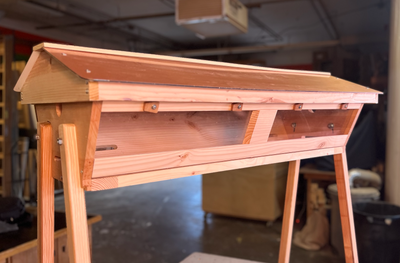Beeswax Basics and Wax-Cloth

Warm days at our apiary in Portland, Oregon still reach summer temperatures, but evenings carry the chill of fall. With the changing seasons come changes to the beekeeping routine, including a honey harvest from thriving hives. This bounty of honey captures the imagination, and we sometimes forget another fantastic hive resource: beeswax.
For foundationless beekeepers who crush and strain their honey, this wax becomes an inevitable byproduct of any honey harvest. Rather than discard your wax, we’d love to help you turn it from a waste product to an ingredient for crafting and wellness. Before we cover that process, let’s cover the beeswax basics:
Beeswax is a natural wax, solid at room temperature, that worker bees produce from glands on their abdomen. The rate of wax production depends on many things within the hive, including the season, the food supply, colony size, and individual colony needs. The wax comb serves as a storehouse, a nursery, a communication medium, and a filter for toxins. Wax naturally stiffens and darkens with age as it absorbs debris from the hive.

Before wax from your hive can find its way into salves and balms, it will require heating and filtration. There are a variety of methods for this, but today we’ll cover a simple home-scale techinique. Most wax filtration involves melting the wax to separate solid impurities, filtering the liquid wax, and allowing the purified wax to solidify.
As always, any activity that involves molten wax is inherently risky, so please work carefully and supervise children at all times. Wax fires are especially dangerous, so never heat wax over an open flame-- electric stoves are a better option, and we prefer to heat our wax using a crock pot on “low”.
For this filtration method, you will need:
-Wax comb from your hive
-Nylon mesh stockings for filtering
-Pot for melting
-Tongs
-Water
**note: we recommend having dedicated wax crafting tools. While you can clean off beeswax using boiling hot water, we find it much easier to assemble a basic kit of equipment reserved for wax. Likewise, we recommend working over newspaper or butcher paper to soak up spills.

Begin by breaking your comb into small pieces. A bit of honey leftovers will be fine, but if things are very sticky you may want to place the wax in front of your hive and allow the bees the clean it thoroughly. Pack your nylon stocking with comb chunks, make a simply knot at the top to seal in the stocking and place it in a your pot with about an inch of water.
Over low heat, warm the water until the wax within the stocking becomes liquid and seeps out (usually within an hour). At this point, carefully remove your stocking and use tongs or a heatproof plastic glove to wring out any remaining wax back into the pot. Feel free to discard the contents of the stocking (these leftovers are called “slumgum”). Remove your pot from heat and allow to cool completely. The wax will solidify into a layer on the water’s surface, allowing you to collect it for later use. You can store your wax in this form, or melt it again to pour into molds.


Depending on your final purpose, you can also repeat this purification process with clean water to achieve purer, lighter colored wax.


From candles to lip balm, soap to mustache wax, beeswax has countless uses. One of our favorites: wax-cloth. This durable, waterproof material was once a staple in outdoor equipment and has recently enjoyed a resurgence in popularity. Simple squares of wax-cloth make an excellent reusable alternative to plastic wrap for bundling for picnic supplies, packed lunches, or anything else that requires a waterproof wrapper.
To make wax-cloth, simply soak your fabric of choice in a pot of hot, liquid beeswax.
Once the fabric has become saturated with wax, remove with tongs and allow excess wax to drip back into the pot. Hang the cloth to dry, keeping in mind that some wax will continue to drip. The finished wax-cloth will be stiff initially and slightly self-adhesive--perfect for protecting your sandwich. After use, simply clean with a damp cloth and hang dry.






Leave a comment